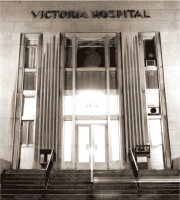1930 - 1945: Depression and WWII
1910–19291946–1969 For Western Society, the decade and a half from 1930 to 1945 brought years of debilitating economic depression which were abruptly terminated by a second world war.Nonetheless, local medical care is needed no matter what the national or international circumstances. Victoria Hospital continued to decide on priorities and make changes.
More Information
The economic depression resulted in higher rates of unemployment and of individual’s ability to pay for medical and other social services. Londoners who could not afford to pay for medical care and hospitalization could enter Victoria Hospital free of charge as public ward patients.
The non-paying public ward patients increased from 53% of the hospital population in 1931 to 69% one year later in 1932. The Hospital Trustees and management were forced to cut costs wherever possible, focusing on wage reductions.
By the mid 1930s, the growing number of patients, deteriorating facilities, rising medical expectations and larger local population made necessary the expansion of the hospital. Overcrowding at Victoria Hospital reached 35% above capacity. Patient care beds were set up in hospital sun rooms and administrative offices to meet the demands.
Project organizers raised funds from the provincial government, the Harry Meek Fund, a public fund-raising campaign and the City of London for a total of $400,000. The estate of the late Mrs. Hadley Williams designated for the proposed new wing added $280,000 to the construction project.
After the old hospital building was demolished in 1939, the new North Wing was opened to the public in late September 1941, accommodating 400 patients. The six-storey, E-shaped building would serve as the main unit of a new hospital complex; additions would be constructed in the future.
During WWII, the labour situation changed from having too many available workers to having too few. Most hospital employees found themselves with increased workloads and a longer work week, some working 72 hours a week. Both staff nurses and non-medical staff sought higher wages and reduced hours of work.
The London and District Hospital Employee’s Federal Union, Local 85, had been in existence since May 1941 and by 1944 had 144 members who worked at Victoria Hospital. On October 26, 1944, the Hospital Trust formally recognized the union as the sole bargaining agency for several classifications of non-medical employees.
The dispute for nurses was turned over to representatives of the Canadian Nurses Association and the Ontario Hospital Association. As part of these negotiations, the Minister of Health directed that a province-wide wage scale for nurses be established.
Excerpts from "Growing to serve... : a history of Victoria Hospital, London, Ontario." Authors: Norman. John Robert Sullivan, Norman R. Ball, and Victoria Hospital Corporation. Published: 1985 by Victoria Hospital Corporation, London, Ontario.







